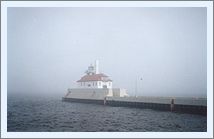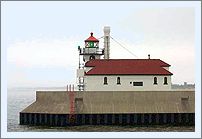 |
 |
 |
| Click thumbnails to view enlarged versions | ||
| Duluth South Breakwater Light | Seeing The Light |
|
|
|
|
Historical Information
The bars' location offshore created a natural breakwater protecting the waters of St. Louis Bay, and with the river established as the border between the states of Wisconsin and Minnesota, the rival ports of Duluth and Superior grew separately on each side of the river. In the early 1850's, there was but a single opening in the bar, known as Superior Entry, and all vessels entering either harbor were forced to negotiate this single void. With the new locks at Sault Ste Marie planned for completion in 1855, both cities on either side of the river were looking forward to a dramatic surge in commerce. Realizing that traffic through Superior Entry would increase dramatically as a result of vessel traffic being opened up to the lower lakes, Congress appropriated $15,000 for the construction of a station on Minnesota Point to light Superior Entry on August 3, 1854. As Duluth grew through the 1860's, a strong rivalry began between the two towns at the opposite ends of Minnesota Point. Resenting that vessels making for Duluth had to pass through the Point at its Wisconsin end, the people of Duluth attempted to build docks on the outer side of the sand bar, to avoid having to use the Superior Entry. However, the docks were no match for Lake Superior's fury, and they quickly deteriorated. The citizens of Duluth petitioned the Government to construct a canal through Minnesota Point at its Duluth end, and while the Army Corps of Engineers conducted a study in response, they advised against its construction, fearing that water levels behind Minnesota Point would be adversely affected.
With the completion of the Lake Superior and Mississippi Railroad connecting Duluth to St. Paul, it was plain that Duluth would take on an even greater role, as trainloads of produce from the west began making their to the Duluth docks to be loaded onto vessels bound for the industrial centers of the lower lakes. While entry through the new canal was relatively easy during daylight hours, locating the narrow channel was virtually impossible under the dark of the Lake Superior night. In response to a request from the Lighthouse Board, Congress appropriated $10,000 for the construction of a light at the canal's entrance in March 1870. Deciding that the best location for the new light would be on the outer end of the new south breakwater, construction had to wait until 1872 when the new breakwater was planned for completion. A contract for construction of the station was issued by the Detroit Depot, and work began late in the summer of that year. After the construction of a keepers dwelling on shore at the inner end of the pier, the crew had turned their attention to the construction of the elevated walk when a violent storm ripped a large part of the wooden breakwater apart, forcing work to be abandoned for the season. Work on reconstructing the breakwater began the following spring, and with its completion the lighthouse contractors returned to Duluth and work resumed on the new station. The tower that took shape at the end of the breakwater was of the standard pyramidal wooden pierhead design being used throughout the lakes at that time. Capped with an octagonal cast iron lantern housing a Fifth Order Fresnel lens, the tower's 40-foot focal plane provided the fixed red light a range of visibility of 12 ˝ miles during clear weather. A wooden elevated walk stretched across the top of the breakwater from near the keeper's dwelling to the tower, allowing the keepers to make their way out to the tower above the waves which frequently ripped violently across the breakwaters surface. While construction of the station was expected in January of 1974, less than stellar performance on the part of the contractor delayed the initial exhibition of the light to the night of June 2, 1874. With Duluth's increasing in importance as a maritime port, at an as yet unidentified date, the Fifth Order lens was upgraded to a fixed red Fourth Order Fresnel lens manufactured by Barbier & Fenestre of Paris in 1877.
1895 in Duluth was the foggiest on record, and the station's keepers were doubtless kept busy feeding 45 tons of coal into the station's insatiable boilers in order to keep the whistles screaming a record 1,048 hours. The citizenry of Duluth was less than enamored with the seemingly constant cacophony, and lodged numerous complaints that the noise was making life unbearable as the sound echoed through the city streets and hills on which the city was built. In reaction, a crew was dispatched to Duluth to relocate the horns to the roof and shrouded them with a large wood and iron parabolic reflector in an attempt to direct the sound out to sea, and away from the city. The experiment was apparently a success, since it not only diminished the ambient sound heard in Duluth but almost doubled the audible range of the signal across the lake.
Surprisingly, over the ensuing
years, the citizenry of Duluth grew to miss the "Bee-Oh" sound
of the old diaphone, and a number of newspaper articles began appearing
in which people waxed longingly for a return of the old diaphone sound. In response, a
group of interested citizens gathered together in 1976 to form TOOT (an
acronym for ReTurn Our Old Tone,)
and after conducting considerable in-depth research, managed to work an
agreement with the Coast Guard to allow the reinstallation of a diaphone
on the South Breakwater. Locating a pair of Type "F" diaphones
which had been previously removed from the Kewaunee Pierhead
Light, the
diaphones were shipped to Duluth where they were completely rebuilt and
installed in the South Breakwater fog signal building. With a large
crowd on the piers to witness the event, the diaphones were reactivated
on April 1, 1995. There is a "skyway" consisting of enclosed walkways between all of the downtown blocks, and this skyway system is surrounded by various types of retail establishments. The old harbor area features restaurants and hotels built in the old warehouse buildings, and is adjacent to spreading civic center featuring convention center, Imax theater, hockey arena, and concert hall. While in the
area, be sure to visit the the Canal Park Maritime Museum which is run by the
Army Corps of Engineers, and located on the north side of the
canal tight against the lift bridge. We
found this to be a fascinating museum, with various displays relating to
Great Lakes shipping history, and highly recommend including a visit
during any visit to Duluth. Museum hours vary
by season. Summer hours generally are 10 a.m. to 9 p.m. daily; Spring
and Fall hours are 10 a.m. to 4:30 p.m. daily, and Winter hours are 10
a.m. to 4 p.m. Friday through Sunday. For more information, call the
museum at (218) 727-2497 |